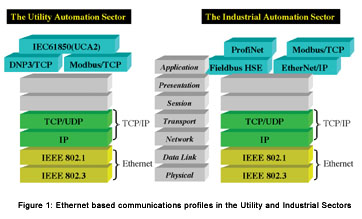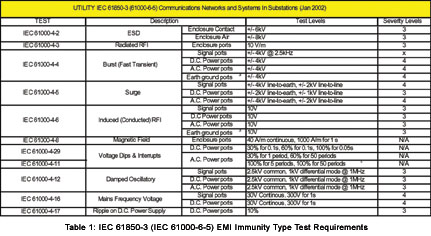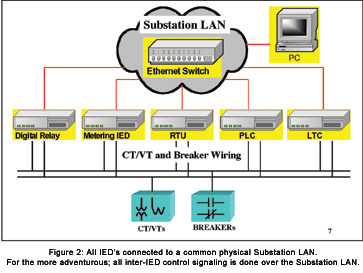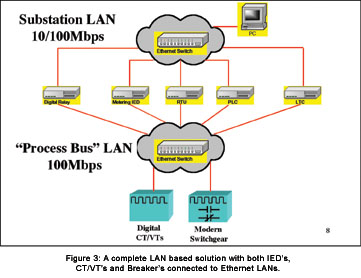Introduction
The proliferation of Ethernet networking technology from the office environment to the substation environment for use in real-time mission critical control applications has resulted in both the IEC and IEEE developing new standards addressing networking equipment in substations. In both cases the standards define conditions that require the networking equipment to operate without any loss or interruption of communications during the application of a variety destructive EMI immunity type tests. These type tests are essentially the same type tests applied to protective relaying devices and utilize essentially the same test levels. Since the protective relaying devices are required to pass these type tests without ‘misoperation’ or damage, the equivalent is also required of the networking equipment to which these devices are being connected to. Zero-Packet-Loss under EMI stress is the networking equivalent of no ‘misoperation’ under EMI stress for protection relays.
This paper explores the emerging trends of using the network to perform mission critical real-time control applications, the new IEC and IEEE standards for communications systems and networking equipment in the substation, and the reasons/needs for Zero-Packet-Loss in the substation.
Ethernet in the Substation – Why ?
Not so very long ago every major vendor of relays, remote terminal units (RTU), meters and programmable logic controllers (PLC), to name but a few intelligent electronic devices (IED) used in substations, had their own communications protocol. What this often meant was that most of the IED’s were incompatible even at the physical layer interface as well as the communications protocol layer. Therefore, as was often the case, some sort of protocol converter device was required to bring all of the IED’s onto a common physical network and perform the translation to allow everyone to speak a common application layer protocol. This resulted in expensive integration with often-poor performance because of the insertion of protocol converters. To remedy these woes utilities turned to the Electric Power Research Institute (EPRI), and along with IED manufacturers and leading utilities such as American Electric Power, collaborated to develop the Utility Communications Architecture (UCA2.0) which is soon to be released as international standard IEC 61850. It provides a set of standards and specifications with a common application layer protocol, to ensure everyone speaks the same language, and several communications profiles, with Ethernet at the physical layer, to ensure everyone resides on the same physical network. This is because Ethernet brings with it a multitude of advantages:
In the process control industry (i.e. industrial automation) a similar transformation has taken place with every major vendor of process control IED’s now providing Ethernet connectivity to the degree that many have espoused the notion that “Ethernet is becoming the RS232 for process control…”
New Standards Covering Networks in Substations
IEC - First Off the Mark
In January 2002, the International Electrotechnical Commission (IEC) released a new standard entitled IEC 61850-3 “Communications networks and systems in substations” to specifically address the general environmental and electromagnetic interference (EMI) immunity requirements for network equipment used in substations. In particular, section 5.7 EMI Immunity states that “The general immunity requirements for the industrial environment are considered not sufficient for substations. Therefore, dedicated requirements are defined in IEC 61000-6-5…” [1]. Table 1 below summarizes the possible worst case test levels defined by IEC 61000-6-5 depending on location of the equipment within the substation.
Of critical importance in the IEC 61000-6-5 specification is the performance criteria defined for key functions within the substation. Essentially, it allows for no delays or data loss for critical functions such as Protection and Teleprotection functions, On-line Processing and Regulation, and Metering when exposed to various EMI phenomena [2].
IEEE – Following Suit
The Substations Committee of the IEEE Power Engineering Society via the C2TF1 Task Force was also busy in 2002 producing its own equivalent standard for communications networks in substations entitled IEEE P1613 -
“Environmental and Testing Requirements for Communications Networking Devices in Electric Power Substations” which as of December 2002 had gone through formal balloting and passed with 95% approval. Table 2 below summarizes the key EMI immunity requirements defined in the standard.
A key definition in the soon to be released standard is the definition of two classes of communications devices: Class 1 communications devices allow for communications errors and delays during the application of the required type tests while Class 2 devices allow for no communications errors or delays during the application of the required type tests [3].
The Essence of Zero-Packet-Loss Under EMI Stress
For an Ethernet LAN in the substation the performance requirements of IEC 61850-3 for critical functions and IEEE P1613 Class 2 devices translate to zero-packet-loss under EMI stress which in practical terms means that one must be able to apply all of the EMI type tests listed in Tables 1 & 2 above while network traffic through the Ethernet LAN is at its maximum (i.e. 100% frame/packet rate) and experience no frame/packet errors, delays or losses. This in essence guarantees that the LAN equipment has the same level of EMI immunity as the protective relaying IED’s connected to it. Bear in mind that protective relaying IED’s must also pass these very same type tests under simulated operational conditions without any ‘misoperation’ or failures.
When is Zero-Packet-Loss Under EMI Stress Needed?
Utilities and vendors alike are no longer simply talking about pilot projects and proof of concept scenarios. In ever-growing numbers utilities in North America and around the world are deploying substation Ethernet LAN’s and leveraging them to perform a variety of tasks.
Those who tread cautiously are doing the following:
For this level of performance Zero-Packet-Loss is optional.
The more ‘adventurous’ are starting to do the following:
The truly “visionary” are looking at:
For this level of performance and critical functionality of the LAN Zero-Packet-Loss under EMI is an essential requirement.
For this level of performance and critical functionality of the LAN Zero-Packet-Loss under EMI is a must!
Conclusions
Zero-Packet-Loss performance by networking equipment in the substation environment is essential for current trends to continue. The basic requirement of having all of the electronic equipment involved in the protection and control system (i.e. Relays, PLC’s, and the LAN) capable of passing the same EMI immunity type tests without ‘misoperation’ will give protection and control engineers the confidence to take advantage of the many new possibilities afforded to them by a high-speed LAN based system.
About the Author:
Marzio Pozzuoli is the founder and president of RuggedCom Inc., a company which designs and manufactures substation hardened networking and communications equipment. Prior to founding RuggedCom Mr. Pozzuoli was the Technology Manager for GE Power Management / Multilin where he developed advanced numerical protective relaying systems and substation automation technology. Mr. Pozzuoli graduated from Ryerson Polytechnical Institute, Toronto, Ontario in 1986 with a Bachelor of Electrical Engineering Technology. He holds multiple patents related to advances in communications, protective relaying technology, and automation technology. He is also an active member of the IEEE and is involved standards work as a member of the IEEE Power Engineering Society Substations Committee task force C2TF1 working on developing a standard for communications networking devices in substations.
References:
[1] IEC 61850-3: Communications networks and systems in substations – Part 3: General Requirements (Section 5.7 - EMI Immunity)
[2] IEC 61000-6-5: Electromagnetic Compatibility (EMC) – Part 6-5: Generic Standards – Immunity for Power Station and Substation Environments (Section 8 - Performance Criteria)
[3] IEEE P1613: Draft Standard Environmental and Testing Requirements for Communications Networking Devices in Electric Power Substations (Sections 7.12, 8.9, 9.2 – Device Performance Classes )
The proliferation of Ethernet networking technology from the office environment to the substation environment for use in real-time mission critical control applications has resulted in both the IEC and IEEE developing new standards addressing networking equipment in substations. In both cases the standards define conditions that require the networking equipment to operate without any loss or interruption of communications during the application of a variety destructive EMI immunity type tests. These type tests are essentially the same type tests applied to protective relaying devices and utilize essentially the same test levels. Since the protective relaying devices are required to pass these type tests without ‘misoperation’ or damage, the equivalent is also required of the networking equipment to which these devices are being connected to. Zero-Packet-Loss under EMI stress is the networking equivalent of no ‘misoperation’ under EMI stress for protection relays.
This paper explores the emerging trends of using the network to perform mission critical real-time control applications, the new IEC and IEEE standards for communications systems and networking equipment in the substation, and the reasons/needs for Zero-Packet-Loss in the substation.
Ethernet in the Substation – Why ?
Not so very long ago every major vendor of relays, remote terminal units (RTU), meters and programmable logic controllers (PLC), to name but a few intelligent electronic devices (IED) used in substations, had their own communications protocol. What this often meant was that most of the IED’s were incompatible even at the physical layer interface as well as the communications protocol layer. Therefore, as was often the case, some sort of protocol converter device was required to bring all of the IED’s onto a common physical network and perform the translation to allow everyone to speak a common application layer protocol. This resulted in expensive integration with often-poor performance because of the insertion of protocol converters. To remedy these woes utilities turned to the Electric Power Research Institute (EPRI), and along with IED manufacturers and leading utilities such as American Electric Power, collaborated to develop the Utility Communications Architecture (UCA2.0) which is soon to be released as international standard IEC 61850. It provides a set of standards and specifications with a common application layer protocol, to ensure everyone speaks the same language, and several communications profiles, with Ethernet at the physical layer, to ensure everyone resides on the same physical network. This is because Ethernet brings with it a multitude of advantages:
- 10Mbps, 100Mbps, 1Gbps, 10Gbps and growing speeds!
- Support for fiber, copper and wireless media!
- Network redundancy and fault tolerant ring architectures per IEEE 802.1w Rapid Spanning Tree protocol
- Message Prioritization and Class of Service for real-time control per IEEE 802.1p Priority Queuing
- Virtual LAN’s which allows for traffic isolation and system security per IEEE 802.1Q VLAN
- Deterministic (yes that’s right I said ‘deterministic’) full-duplex operation with no collisions per IEEE 802.3x Flow Control (Modern Ethernet Switches which support IEEE 802.3x do not allow, nor support, nor experience collisions! Collisions are a thing of the past associated with Ethernet networks implemented using shared media hubs/repeaters.)
- Ethernet is the world’s most widely adopted local area network (LAN) technology and is now migrating into the wide area networking (WAN) space. In the future we could see a total Ethernet solution from the WAN to the MAN (Metropolitan Area Network) to the LAN.
- Every major manufacturer of IED’s (e.g. Relays, RTU’s, Meters, PLC’s) now provides at least one (some provide dual) Ethernet port on their devices.

In the process control industry (i.e. industrial automation) a similar transformation has taken place with every major vendor of process control IED’s now providing Ethernet connectivity to the degree that many have espoused the notion that “Ethernet is becoming the RS232 for process control…”
New Standards Covering Networks in Substations
IEC - First Off the Mark
In January 2002, the International Electrotechnical Commission (IEC) released a new standard entitled IEC 61850-3 “Communications networks and systems in substations” to specifically address the general environmental and electromagnetic interference (EMI) immunity requirements for network equipment used in substations. In particular, section 5.7 EMI Immunity states that “The general immunity requirements for the industrial environment are considered not sufficient for substations. Therefore, dedicated requirements are defined in IEC 61000-6-5…” [1]. Table 1 below summarizes the possible worst case test levels defined by IEC 61000-6-5 depending on location of the equipment within the substation.

Of critical importance in the IEC 61000-6-5 specification is the performance criteria defined for key functions within the substation. Essentially, it allows for no delays or data loss for critical functions such as Protection and Teleprotection functions, On-line Processing and Regulation, and Metering when exposed to various EMI phenomena [2].
IEEE – Following Suit
The Substations Committee of the IEEE Power Engineering Society via the C2TF1 Task Force was also busy in 2002 producing its own equivalent standard for communications networks in substations entitled IEEE P1613 -
“Environmental and Testing Requirements for Communications Networking Devices in Electric Power Substations” which as of December 2002 had gone through formal balloting and passed with 95% approval. Table 2 below summarizes the key EMI immunity requirements defined in the standard.
A key definition in the soon to be released standard is the definition of two classes of communications devices: Class 1 communications devices allow for communications errors and delays during the application of the required type tests while Class 2 devices allow for no communications errors or delays during the application of the required type tests [3].
The Essence of Zero-Packet-Loss Under EMI Stress
For an Ethernet LAN in the substation the performance requirements of IEC 61850-3 for critical functions and IEEE P1613 Class 2 devices translate to zero-packet-loss under EMI stress which in practical terms means that one must be able to apply all of the EMI type tests listed in Tables 1 & 2 above while network traffic through the Ethernet LAN is at its maximum (i.e. 100% frame/packet rate) and experience no frame/packet errors, delays or losses. This in essence guarantees that the LAN equipment has the same level of EMI immunity as the protective relaying IED’s connected to it. Bear in mind that protective relaying IED’s must also pass these very same type tests under simulated operational conditions without any ‘misoperation’ or failures.

When is Zero-Packet-Loss Under EMI Stress Needed?
Utilities and vendors alike are no longer simply talking about pilot projects and proof of concept scenarios. In ever-growing numbers utilities in North America and around the world are deploying substation Ethernet LAN’s and leveraging them to perform a variety of tasks.
Those who tread cautiously are doing the following:
- IED data collection and monitoring over a high-speed (10/100Mbps) LAN.
- Leveraging the fact that Ethernet LANs allow IED’s supporting different application layer protocols (e.g. Modbus/TCP, DNP3.0, UCA2.0) to co-exist harmoniously on a common physical network without protocol converters. This allows one to continue to leverage the investment made in existing protocols and incrementally migrate to a common protocol such as UCA/61850 when there is a sufficient comfort factor.
For this level of performance Zero-Packet-Loss is optional.
The more ‘adventurous’ are starting to do the following:
- Relay ‘Trip’ and ‘Block’ signaling via UCA/61850 GOOSE messaging over the LAN.
- Relay Voting Schemes (e.g. 2 out of 3 relays say ‘TRIP’) – where again GOOSE messaging is used over the LAN.
- Bus Blocking/Trip Co-ordination schemes via GOOSE message signaling over the LAN.
- Load shedding and restoration schemes via GOOSE messaging over the LAN.
The truly “visionary” are looking at:
- A complete LAN based solution where even the CT/VT wiring and breaker control wiring has been replaced by single IED’s which interface to the CT’s and VT’s and provide all the current, voltage and other power system parameters over the LAN in a broadcast manner allowing any or all IED’s connected to the LAN to have access to this information.

For this level of performance and critical functionality of the LAN Zero-Packet-Loss under EMI is an essential requirement.
- At present companies such as ABB, Siemens and Alstom have been collaborating and have developed digital CT/VT sensors and breaker IED’s which interface to a 100Mbps Ethernet LAN. This is often referred to in the industry as a “process bus” and is accommodated in sections of soon to be released IEC 61850 specification.

For this level of performance and critical functionality of the LAN Zero-Packet-Loss under EMI is a must!
Conclusions
Zero-Packet-Loss performance by networking equipment in the substation environment is essential for current trends to continue. The basic requirement of having all of the electronic equipment involved in the protection and control system (i.e. Relays, PLC’s, and the LAN) capable of passing the same EMI immunity type tests without ‘misoperation’ will give protection and control engineers the confidence to take advantage of the many new possibilities afforded to them by a high-speed LAN based system.
About the Author:
Marzio Pozzuoli is the founder and president of RuggedCom Inc., a company which designs and manufactures substation hardened networking and communications equipment. Prior to founding RuggedCom Mr. Pozzuoli was the Technology Manager for GE Power Management / Multilin where he developed advanced numerical protective relaying systems and substation automation technology. Mr. Pozzuoli graduated from Ryerson Polytechnical Institute, Toronto, Ontario in 1986 with a Bachelor of Electrical Engineering Technology. He holds multiple patents related to advances in communications, protective relaying technology, and automation technology. He is also an active member of the IEEE and is involved standards work as a member of the IEEE Power Engineering Society Substations Committee task force C2TF1 working on developing a standard for communications networking devices in substations.
References:
[1] IEC 61850-3: Communications networks and systems in substations – Part 3: General Requirements (Section 5.7 - EMI Immunity)
[2] IEC 61000-6-5: Electromagnetic Compatibility (EMC) – Part 6-5: Generic Standards – Immunity for Power Station and Substation Environments (Section 8 - Performance Criteria)
[3] IEEE P1613: Draft Standard Environmental and Testing Requirements for Communications Networking Devices in Electric Power Substations (Sections 7.12, 8.9, 9.2 – Device Performance Classes )







